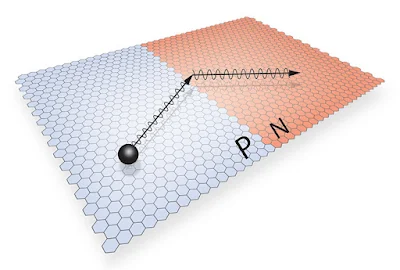Οι
ανιχνευτές LIGO
ανίχνευσαν ρυτιδώσεις που σχηματίστηκαν στον χωροχρόνο από τη σύγκρουση δύο
μελανών οπών. Gravitational waves emerging from the collision of two
black holes. Credit: LIGO
Ήταν
βέβαια αναμενόμενο: η ανίχνευση βαρυτικών κυμάτων που επιβεβαίωσε φέτος μια από
τις τελευταίες προβλέψεις του Αϊνστάιν ανακηρύχθηκε η κορυφαία ανακάλυψη στη
Φυσική για το 2016 από το περιοδικό Physics World.
Τα βαρυτικά κύματα είναι «ρυτιδώσεις» του χωροχρόνου, που προκαλούνται από βίαια κοσμικά συμβάντα, όπως η σύγκρουση μεταξύ μαύρων οπών. Είχαν προβλεφθεί θεωρητικά στο πλαίσιο της Γενικής Σχετικότητας, ανιχνεύθηκαν όμως για πρώτη φορά τον Φεβρουάριο από τους ανιχνευτές LIGO στις ΗΠΑ.
Περισσότερα από 80 πανεπιστήμια και άλλοι ερευνητικοί φορείς από όλο τον κόσμο συμμετέχουν στην κοινοπραξία LIGO, με επικεφαλής ερευνητές από τα αμερικανικά πανεπιστήμια ΜΙΤ και Caltech.
Τα βαρυτικά κύματα είναι «ρυτιδώσεις» του χωροχρόνου, που προκαλούνται από βίαια κοσμικά συμβάντα, όπως η σύγκρουση μεταξύ μαύρων οπών. Είχαν προβλεφθεί θεωρητικά στο πλαίσιο της Γενικής Σχετικότητας, ανιχνεύθηκαν όμως για πρώτη φορά τον Φεβρουάριο από τους ανιχνευτές LIGO στις ΗΠΑ.
Περισσότερα από 80 πανεπιστήμια και άλλοι ερευνητικοί φορείς από όλο τον κόσμο συμμετέχουν στην κοινοπραξία LIGO, με επικεφαλής ερευνητές από τα αμερικανικά πανεπιστήμια ΜΙΤ και Caltech.
Οι υπόλοιπες
εξελίξεις που συμπληρώνουν το Top
10 του Physics World:
The ion trap used
by Dave Wineland and colleagues at NIST to entangle two different kinds of
ions. The gold-on-alumina trap can be seen in the oval window at the centre of
the photograph. The oval window is about 2 cm across. (Courtesy:
Blakestad/NIST)
Η
δημιουργία και μέτρηση της κβαντικής διεμπλοκής ανάμεσα σε ζεύγη διαφορετικών
ιόντων.
An image of the ion
trap inside the vacuum chamber. (Courtesy:
Johannes Roßnagel)
Η
μηχανή που αποτελείται από ένα μόνο άτομο.
The new gravimeter
is held within this fused-silica support structure. The proof mass is
illuminated by an LED and its position is detected by its shadow on a
photodiode. (Courtesy: Giles
Hammond)
Η
δημιουργία ενός άκρως ευαίσθητου, μικρού και φθηνού μετρητή βαρύτητας.
Researchers have
created a two-mode "Schrödinger's cat state" for the first time. (Courtesy: Michael S Helfenbein/Yale
University)
Η
δημιουργία μιας γάτας του Σρέντιγκερ που ζει και πεθαίνει σε δύο κουτιά
ταυτόχρονα.
Illustration of
electrons undergoing negative refraction at a p–n junction in graphene. (Courtesy: Cory Dean)
Η
μέτρηση της αρνητικής διάθλασης των ηλεκτρονίων στο γραφένιο.
This artist's
impression shows a view of the surface of the planet Proxima b orbiting the
red-dwarf star Proxima Centauri, the closest star to the solar system. The
double star Alpha Centauri AB also appears in the image to the upper-right of
Proxima itself. Proxima b is a little more massive than the Earth and orbits in
the habitable zone around Proxima Centauri, where the temperature is suitable
for liquid water to exist on its surface. (Courtesy:
ESO/M Kornmesser)
Η
ανακάλυψη του πλησιέστερου στη Γη βραχώδους εξωπλανήτη στον Εγγύτατο του
Κενταύρου.
The experimental
set-up used by Lars von der Wense and colleagues to make the first direct
detection of the excited nuclear state Th-229m. The various vacuum chambers
house (from left to right) the buffer-gas cell containing the uranium isotope
U-233, and the instruments dedicated to ion-beam extraction, mass separation
and determination of the decay spectrum. (Courtesy:
L von der Wense/LMU)
Το
πυρηνικό ρολόι με βάση το θόριο-229.
Image of a mouse
embryo taken using the new mesolens. The large rectangle shows a
high-resolution detail of the mouse's eye contained within the small white
rectangular frame in the main image. (Courtesy: Gail McConnell/University of
Strathclyde)
Ένας νέος φακός μικροσκοπίου που συνδυάζει μεγάλο οπτικό πεδίο και υψηλή ανάλυση.
Artist's impression
of the production of an electron–positron pair. (Courtesy: IQOQI/Harald Ritsch)
Η
προσομοίωση των αλληλεπιδράσεων μεταξύ θεμελιωδών σωματιδίων με τη χρήση κβαντικού
υπολογιστή.
Πηγή: physicsworld.com
Πηγή: physicsworld.com











Δεν υπάρχουν σχόλια:
Δημοσίευση σχολίου